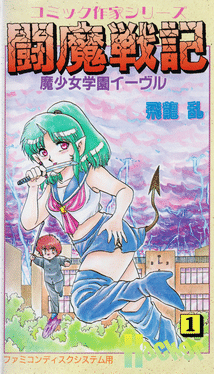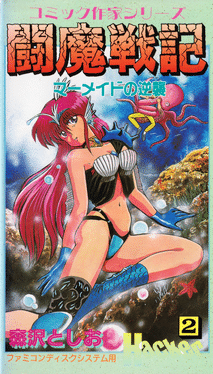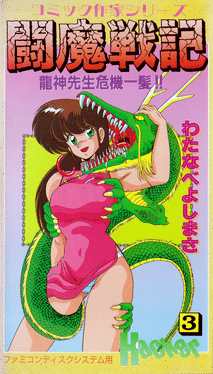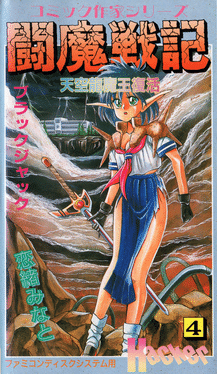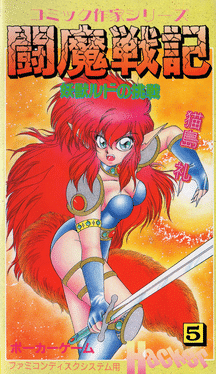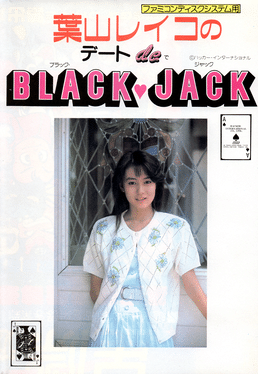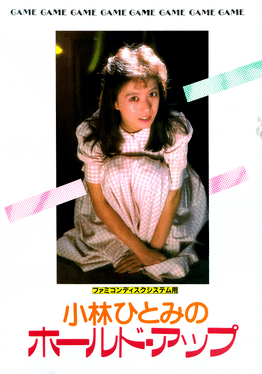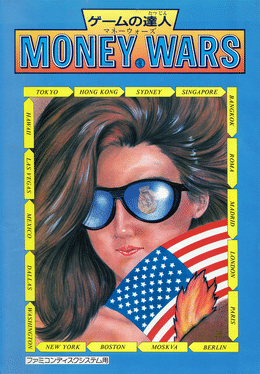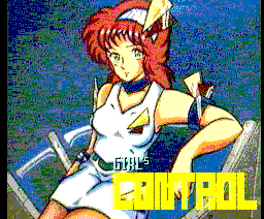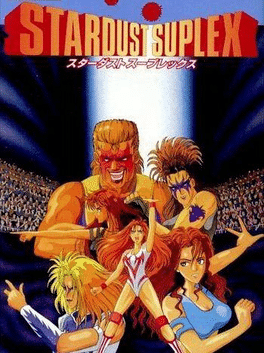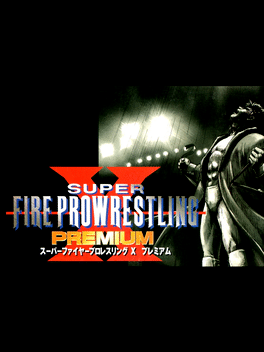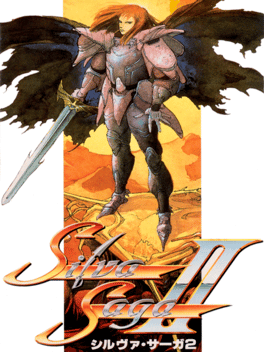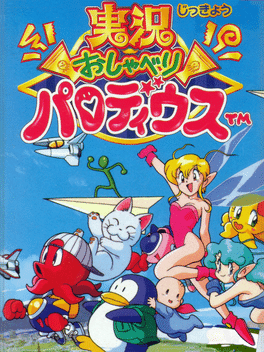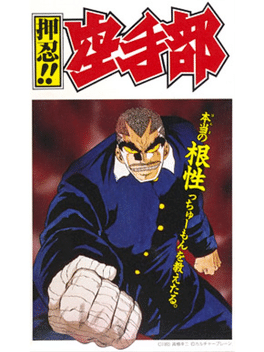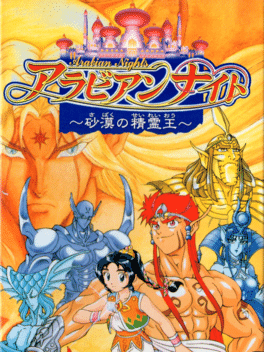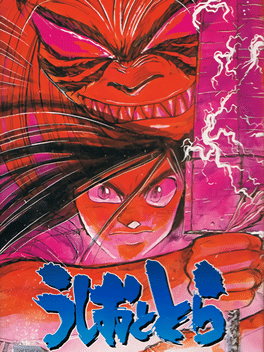Most Popular Super Famicom Games - Page 23
-
Comic Sakka Series Touma Senki #1: Mashoujo Gakuen Evil
1990
An adult side scrolling shooter game in which you fly and blast enemies and after the end of each stage you will get to see a demon girl slowly undress. -
Comic Sakka Series Touma Senki #2: Mermaid no Gyakushuu
1990
An adult side scrolling shooter game in which you fly and blast enemies and after the end of each stage you will get to see a mermaid girl slowly undress. -
Comic Sakka Series Touma Senki #3: Ryuujin Sensei Kiki Ippatsu
1990
An adult side scrolling shooter game in which you fly and blast enemies and after the end of each stage you will get to see a dragon girl undress. -
Comic Sakka Series Touma Senki #4: Tenkuu Ryuumaou Fukkatsu
1990
An adult game in which you play a warrior girl in poker. If you win enough hands she will slowly undress. -
Comic Sakka Series Touma Senki #5: Youjuu Rudo no Chousen
1990
An adult game in which you play a catgirl in poker. If you win enough hands she will slowly undress. -
Hayama Reiko no Date de Blackjack
1990
Play a round of Blackjack against the beautiful model Reiko Hayama. If you win, you will be rewarded in more ways than one... -
Bishoujo Control
1990
Bishoujo Control
1990
Combining the gameplay of an arcade shoot'em'up with watching pretty girls, Bishoujo Control puts you in a spaceship, battling hordes of enemies flying downwards. All that flies is not an enemy, though; you can also shoot at blocks that, when shot, make up a picture of a pretty girl on the right of the screen. Picking up bonuses in the shape of the signs for "pretty girl" powers up your weapon. When all pieces of the picture are picked up, you are given a chance to enjoy the picture at your own pace before progressing to the next level (and the next girl) -
Bishoujo Kachinuki Renju: Gomoku Narabe
1989
A game of gomoku against girls whom strip off clothes if you win. The game's AI is rather hard to beat, but sometimes it makes glaring tactical mistakes. -
Stardust Suplex
1995
Stardust Suplex
1995
Enter the VLPW, VARIE LADYS PROFESSIONAL WRESTLING. 16 professional wrestlers are ready to fight over the VLPW title. Go one or one or tag team, either against the computer or your own friend! -
Super Fire Pro Wrestling X Premium
1996
In this final appearance of Fire Pro series on 16-bit consoles, the usual roster of over 150 wrestlers from several wresting promotions worldwide including several styles from Shoot or Pancrase to American and Lucha are joined by 80 Create-a-wrestler slots, plus secret wrestlers such as legends Gotch or Thesz or the roster of Blazing Tornado. While all fighters have fictional names, a lot of them are perfectly recognizable by their attire, stance and style. The CAW mode allows the player to create a wrestler from scratch, setting how they look (choosing face, size, clothing and setting colours) and fight, with several styles and stances available, as well as over 500 moves, each more suitable for certain styles and skills. To make them fight more realistically when controlled by the AI, the CAW mode also allows one to set move priorities. Five game modes are available, including World Championship (single and tag), Battle Royale, 5-man Elimination Mode, League Battle and the One Night Dream Match. There are severa -
Dragon Ball Z: Super Goku-den - Totsugeki-hen
1995
Meet a naive young monkey-tailed boy named Goku, whose quiet life changes when he meets Bulma, a girl who is on a quest to collect seven "Dragon Balls." If she gathers them all, an incredibly powerful dragon will appear and grant her one wish. But the precious orbs are scattered all over the world, and Bulma needs Goku's help (and his super-strength)! With a magic staff for a weapon and a flying cloud for a ride, Goku sets out on the adventure of a lifetime... -
Silva Saga II
1993
Silva Saga II
1993
Silva Saga II: The Legend of Light and Darkness is a role-playing video game developed and published by SETA Corporation, which was released exclusively in Japan in 1993. It is a direct sequel to Silva Saga for the Family Computer. The player will find similarities with Dragon Quest. Players search out the soldier of light who travels on a journey to defeat the Zolde, son of the Zuhl. Up to 12 mercenaries and deity statues can be combined as well as organized. -
Jikkyou Oshaberi Parodius
1995
Jikkyou Oshaberi Parodius (Chatty Parodius), is the fourth game in a series of parody shooters produced by Konami. The gameplay is stylistically very similar to the Gradius series, but the graphics and music are intentionally absurd. The game, as its name would suggest, contains a large amount of Japanese voice samples shouted out in a style similar to that of a game show host. Unlike the previous two titles, Jikkyō Oshaberi Parodius was not created as an arcade game. It was first released on the Super Famicom in 1995 and then ported and updated for the PlayStation and Sega Saturn in 1996. -
Nangoku Shounen Papuwa-kun
1994
Once, on an unknown southern island, a battle was waged over two mysterious stones, one red and one blue. The blue stone controls desire, and its power created the blue clan. And the red clan that inherited the power of the red stone was filled with the light of hope. Finally, the battle came to an end, and the young one who possessed the power of the blue stone fell into a deep sleep. The one with the power of the red stone flew off far across the sky. Desire and hope... until the day these two powers meet each other again... -
Holy Umbrella: Dondera no Mubou!!
1994
Holy Umbrella: Dondera no Mubou!! is a platformer only released in Japan for the Super Famicom. The main character gets transported to an alternate world when he picks up an umbrella, and he has to save it to get home. The game is full of all sorts of cliche plot elements. -
Osu!! Karate Bu
1994
Osu!! Karate Bu
1994
A Super Famicom fighter game based on the delinquent martial arts manga of the same name. It was developed and published by Culture Brain in 1994. The game is a standard martial arts one-on-one fighter in most respects, though features a few uncommon aspects. The first of which is that the player's health bar does not replenish after each round, and the fight continues as each bar is depleted. The second is that the player can recover from losing all their health if they have enough on their power (or qi) gauge. The game counts to three, like in professional wrestling, and the player has the chance to recover a small amount of health in exchange for their power. -
Arabian Nights: Sabaku no Seirei-ou
1996
In this Japan-exclusive Super Famicom game, the player assumes the role of an orphan named Shukran, who is accompanied by the djinn Ifrit on her adventures to bring peace to her desert homeland. -
Ushio to Tora
1993
Ushio to Tora
1993
Ushio to Tora is a side-scrolling platform game by Yukata and based on a popular Japanese manga and anime series. It tells the story of Aotsuki Ushio, the son of a temple priest who lives in the family's shrine.
